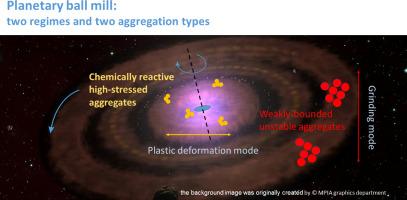高能球磨机中的颗粒聚集和研磨极限
IF 4.5
2区 工程技术
Q2 ENGINEERING, CHEMICAL
引用次数: 0
摘要
在行星式球磨机中对褐煤进行机械化学处理时会形成粉尘聚集体(单个颗粒的团块)。通过比较聚集体和单个颗粒的平均尺寸,可以确定聚集体结构。我们的研究表明,粉尘聚集体一般以规则的方式排列:沿聚集体分布的单个颗粒的数量与穿过聚集体的颗粒的数量相吻合。每个聚集体的单体的幂律分布显示,单个颗粒粘在一起,形成极其密集的团块。每个聚集体的平均单体数量为 ∼104。此外,单体的 "粘性 "与应用能量剂量的关系与机械化学过程的其他特征(单体大小和化学反应深度)同时存在着联系。用机械化学术语来说,这相当于在达到研磨极限后从脆性研磨模式过渡到塑性变形模式。本文章由计算机程序翻译,如有差异,请以英文原文为准。

Particle aggregation and the grinding limit in high energy ball mill
Dust aggregates — clusters of individual particles — are formed during mechanochemical processing of brown coal in a planetary ball mill. The aggregate structure can be identified by comparing the average sizes of aggregates and individual particles. We showed that dust aggregates are generally arranged in a regular way: the number of individual particles located along the aggregate coincides with the number of particles located across the aggregate. Power of power-law distribution of the monomers per aggregate revealed that individual particles stick together in extremely dense clusters. The average number of monomers per claster is ∼104. In addition, it turned out that the dependence of the monomer's “stickiness” on applied energy dose has a kink simultaneously with other characteristics of the mechanochemical process (the monomer size and the chemical reaction depth). Speaking using mechanochemistry terms, it corresponds to transition from the brittle grinding mode to the plastic deformation mode after reaching the grinding limit.
求助全文
通过发布文献求助,成功后即可免费获取论文全文。
去求助
来源期刊

Powder Technology
工程技术-工程:化工
CiteScore
9.90
自引率
15.40%
发文量
1047
审稿时长
46 days
期刊介绍:
Powder Technology is an International Journal on the Science and Technology of Wet and Dry Particulate Systems. Powder Technology publishes papers on all aspects of the formation of particles and their characterisation and on the study of systems containing particulate solids. No limitation is imposed on the size of the particles, which may range from nanometre scale, as in pigments or aerosols, to that of mined or quarried materials. The following list of topics is not intended to be comprehensive, but rather to indicate typical subjects which fall within the scope of the journal's interests:
Formation and synthesis of particles by precipitation and other methods.
Modification of particles by agglomeration, coating, comminution and attrition.
Characterisation of the size, shape, surface area, pore structure and strength of particles and agglomerates (including the origins and effects of inter particle forces).
Packing, failure, flow and permeability of assemblies of particles.
Particle-particle interactions and suspension rheology.
Handling and processing operations such as slurry flow, fluidization, pneumatic conveying.
Interactions between particles and their environment, including delivery of particulate products to the body.
Applications of particle technology in production of pharmaceuticals, chemicals, foods, pigments, structural, and functional materials and in environmental and energy related matters.
For materials-oriented contributions we are looking for articles revealing the effect of particle/powder characteristics (size, morphology and composition, in that order) on material performance or functionality and, ideally, comparison to any industrial standard.
 求助内容:
求助内容: 应助结果提醒方式:
应助结果提醒方式:


